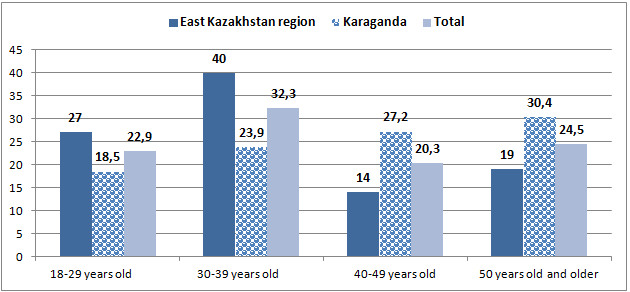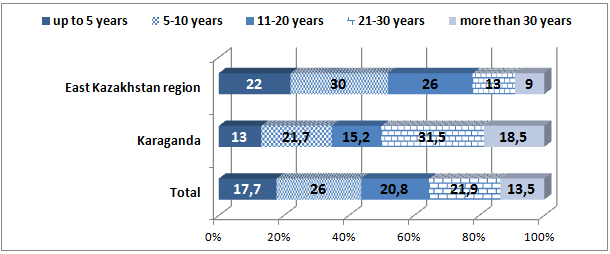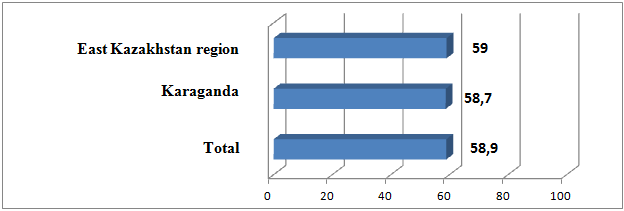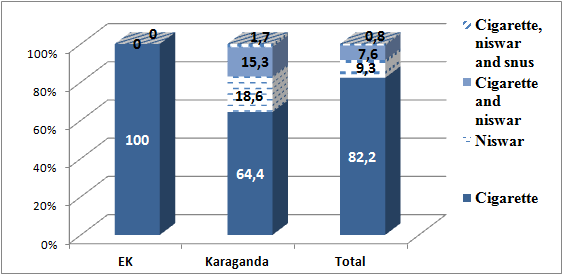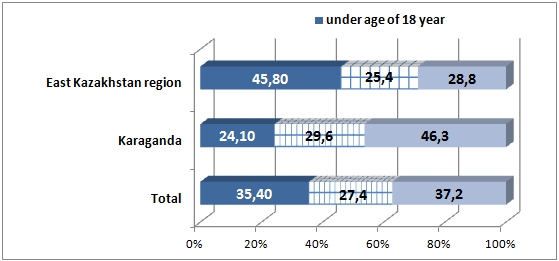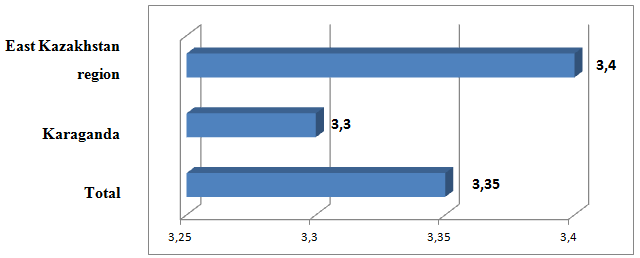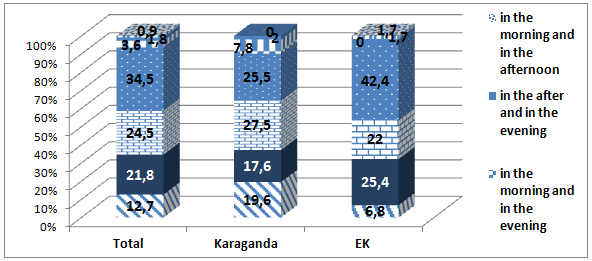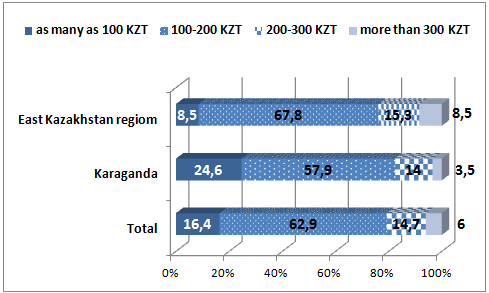ИЗУЧЕНИЕ РАСПРОСТРАНЕННОСТИ ПОТРЕБЛЕНИЯ ТАБАЧНЫХ ИЗДЕЛИЙ СРЕДИ РАБОЧИХ ПРОМЫШЛЕННЫХ ПРЕДПРИЯТИЙ КАЗАХСТАНА
Баттакова Ж.Е.1, Токмурзиева Г.Ж.2, Акимбаева А.А.3 , Адаева А.А.4, Ермухамбетова Т.Н.5
1Доктор медицинских наук, профессор, 2Доктор медицинских наук, 3Магистр медицины, 4Магистр медицины, 5Магистр медицинских наук, Национальный Центр проблем формирования здорового образа жизни, Республика Казахстан, Алматы
ИЗУЧЕНИЕ РАСПРОСТРАНЕННОСТИ ПОТРЕБЛЕНИЯ ТАБАЧНЫХ ИЗДЕЛИЙ СРЕДИ РАБОЧИХ ПРОМЫШЛЕННЫХ ПРЕДПРИЯТИЙ КАЗАХСТАНА
Аннотация
Проведено исследование по распространенности, структуре и характеру потребления табачных изделий, а также эконометрике затрат среди работников горнорудного производства. Установлено, что большинство казахстанских шахтеров 82,2% потребляют сигареты, распространенность потребления некурительных табачных изделий составила наименьшие показатели 9,3% респондентов потребляют насвай, 7,6% - сигареты и насвай. 62,9% рабочих указали, что ежедневно затрачивают от 100 до 200 тенге на покупку сигарет и лишь 1,3% заявили о заинтересованности в приобретении снюса из общей выборки.
Ключевые слова: табачные изделия, насвай, снюс, шахтеры, опрос.
Zh.E. Battakova1, G.Zh. Tokmurziyeva2, A.A. Akimbayeva3, A.A. Adayeva4, T.N. Yermukhambetova5
1Doctor of Medical Sciences, professor, 2Doctor of Medical Sciences, 3Master of medicine, 4Master of medicine, 5Master of Medical sciences, National Centre for Problems of Healthy Lifestyle Development under the Ministry of Health and Social Development of the Republic of Kazakhstan, Almaty city
STUDY PREVALENCE OF TOBACCO USE AMONG THE INDUSTRIAL ORGANIZATION WORKERS IN KAZAKHSTAN
Abstract
A study on the prevalence, nature and structure of the tobacco products use, as well as the costs econometrics among the mining production employees was carried out. It has been established that the majority of Kazakhstani miners (82.2%) consume the cigarettes, the prevalence of the smokeless tobacco products made the lower rates, 9.3% of the respondents use niswar, 7.6% use cigarettes and niswar. 62.9% of workers stated that daily expenses for cigarettes buying is 100 to 200 KZ Tenge, and 1.3% of workers only stated on their interest to buy the snus out of the total selection.
Keywords: tobacco, niswar, snus, miners, survey.
According to the World Health Organization, annually tobacco kills nearly six million people worldwide, including more than six hundred thousand (600.000) non-smokers who die from exposure of the derivate tobacco smoke, it also causes the economic losses of hundreds of billions of US Dollar. An increasing epidemic of the non-communicable diseases which cause the premature mortality of the population is noted currently; in this case the largest contribution is made by the tobacco use [1-4].
Together with 179 countries that have ratified the WHO FCTC (Framework Convention on Tobacco Control), Kazakhstan is successfully performing its international obligation to implement the tobacco control measures to improve the population health. The Law “On ratification of the World Health Organization Framework Convention for the Tobacco Control” was adopted in 2006. It is important to monitor the tobacco use index in the Kazakhstan society for the purpose to apply the measures that reduce the demand for tobacco products and introduce the effective national tobacco control prevention strategies aimed at the life-saving [5-6].
Due to this reason the regular research system for study of the behavioral risk factors (intervals of 3-5 years) has been established in the Republic of Kazakhstan that allows to study the dynamics of tobacco use among the population of the Republic of Kazakhstan. However, so far the process of the industrial workers position to the smoking has not been studied, especially in the underground (mining) working conditions and under the influence of the additional hazardous production factors.
National Centre for Problems of Healthy Lifestyle Development under the RoK Ministry of Health and Social Development had carried out a pilot express survey to study the position of mining and metallurgical industry workers to the use of tobacco products.
The coal miners and mine workers of one shift engaged in the underground operations of the coal or ore mining and smelting industry in Karaganda and East Kazakhstan regions were study targets.
Express survey concerning the use of tobacco products covered the workers of one shift of Kazakhmys Company, Saransk Mine named after Kuzembayev, Karaganda region (92 people) and KazZinc, Ziryanovsk mining and processing complex, Maleyevsky Mine, East Kazakhstan region (100 people) working in the underground environment.
Evaluation of the demographic characteristics of employees of the ore mining and smelting industry in Karaganda and East Kazakhstan regions who work in the underground environment, as well as determination of the tobacco use prevalence were based on the survey results.
The respondents divided into the age group almost equally: 18-29 years persons – 22.9%, 30-39 years – 32.3%, 40-49 years – 20.3%, 50 years and older – 24.5% (Figure 1).
Figure 1 - Age group structuring of the respondents, (%)
In terms of the record of service in the mine, the respondents had divided into the following groups: up to 5 years – 17.7%, 5-10 years – 26%, 11-20 years – 20.8%, 21-30 years – 21.9%, more than 30 years – 13.5%.
The regional differences were distinguished. In East Kazakhstan region, the respondents who have the records of service in the mining industry up to 20 years make a larger portion (78%). In Karaganda, people who have the records of service 21-30 years are the one-third of the total amount, 5-10 years – 21.7% (Figure 2).
Figure 2 - Length of service of the mine respondents, (%)
58.9% of the respondents use the tobacco products (Figure 3). No differences were found in terms of the regions (59% - East Kazakhstan region, 58.7% - Karaganda region).
Figure 3 - Prevalence of the tobacco use, (%)
Cigarettes dominate in the structure of the used tobacco products (82.2%). In East Kazakhstan region, this type of tobacco products was 100%, in Karaganda region – 64.4%. 9.3% of the respondents (11 people) – reported using niswar, 7.6% - cigarettes and niswar (Figure 4).
Figure 4 - Types of the tobacco products used by the respondents, (%)
35.4% of the respondents started to use the tobacco products under 18 years of age, 64.6% of the respondents started in the age of 18 years and older. Some regional differences shall be noted. Thus 45.8% of respondents in East Kazakhstan region specified their start to use the tobacco products under the age of 18 years, in Karaganda region – 24.1% (Figure 5).
Figure 5 - Age of the beginning to use the tobacco products, (%)
96.6% of the respondents gave a negative answer to the question about the use of tobacco products while working in the mine. In terms of the regions, in Karaganda region this portion was 96.7, in East Kazakhstan – 96.6% (Figure 6).
Figure 6 - Use of the tobacco products while working in the mine, (%)
In reply to the question about the period of the most often using the tobacco products, 34.5% of the respondents replied “in morning, in the afternoon, in the evening”. 24.5% of the respondents use the tobacco products in the evening only, 21.8% - in the afternoon, 12.7% - in the morning (Figure 7).
Figure 7 - Period of the tobacco products use, (%)
On daily basis 62.9% of the respondents spend 100-200 KZ Tenge for the tobacco products (67.8% – in East Kazakhstan, and 57.9% – in Karaganda). 24.6% of the respondents in Karaganda region spend as many as 100 KZ Tenge for the tobacco products (Figure 8).
Figure 8 - Expenses of the respondents for the tobacco products (per one day), (%)
The question about the readiness to spend 2000 KZ Tenge for snus on a daily basis was replied by 92 respondents in Karaganda region and 59 respondents in East Kazakhstan region. Only 2.2% of the respondents in Karaganda region gave the positive answers that make up 2 people of those surveyed in the region (Table 1).
Table 1 - Readiness of the respondents to spend 2000 KZ Tenge for snus on a daily basis.
Thus the following data of the prevalence of tobacco use by employees of the coal mining, ore mining and smelting industry were provided based on the results of the pilot express survey.
The respondents are represented equally in the age groups structuring. The age group of 30-39 years made the largest percent (32.3%). The younger people are the majority in East Kazakhstan region (67% - under 40 years of age). In Karaganda region 42.4% are the people under the age of 40 years, 57.6% are the people of the age of 40 years and older.
Generally 68.7% of the respondents have the work experience of 5 to 30 years. 78% of the respondents in East Kazakhstan region have the length of service up to 20 years, and 49.9% of those in Karaganda region.
58.9% of the respondents use the tobacco products. 35.4% of the respondents started using tobacco before the age of 18, 64.6% - from the age of 18 years and older.
The tobacco products structure is dominated by the cigarettes (82.2%). 9.3% of the respondents (11 people) use the niswar, 7.6% of the respondents use the cigarettes and niswar (9 persons). Such percentage is based on the number of the respondents of two companies. The regional differences were found in the East Kazakhstan region, 100% of the respondents consume the cigarettes; in Karaganda 18.6% of the respondents (11 respondents) reported using niswar, 15.3% of the respondents (9 respondents) use the cigarettes and niswar, 1.7% (1 respondent) uses the cigarettes, snus and niswar.
34.5% of the respondents use the tobacco products “in the morning, in the afternoon, in the evening”, 24.5% of the respondents use the tobacco products in the evening only, 21.8% - in the afternoon, and 12.7% - in the morning.
In terms of the financial costs level for purchase of the tobacco products, 62.9% of the respondents stated between 100 and 200 KZ Tenge. 24.6% of the respondents in Karaganda region stated “as many as 100 KZ Tenge”. With respect to the willingness (readiness) of the respondents to spend 2000 KZ Tenge for snus on a daily basis in the East Kazakhstan region, 100% of the respondents gave the negative answer. 2 persons only from among the respondents in Karaganda region stated their readiness of spending 2000 KZ Tenge for snus on a daily basis, which was 1.3% of the total selection.
The data obtained allow to conclude that cigarette smoking is prevalent (82.2%) among the industrial enterprise workers engaged in the underground working environment in terms of use of the types of the tobacco products. Smokeless tobacco products such as niswar is used by 9.3% of the respondents, and only 1.3% of the respondents expressed their interest to buy the snus out of the total selection. The information above made it possible to consider the trends in tobacco use among the working population in the Republic to develop the legislative acts related to implementation of the tobacco control policy in the Republic of Kazakhstan. The Code of the Republic of Kazakhstan “On People’s Health” was amended this year; it was relevant to prohibit the production, import and circulation of the non-smoking tobacco products. These provisions are of particular importance due to the fact that the use of the non-smoking tobacco products is very dangerous (harmful) to the human life and health. The hazardous effects of the non-smoking tobacco include as follows: occurrence of cancer diseases (cancer of tongue, mouth and other mouth cavity organs, and the throat); occurrence of the gastric ulcers due to the long-term use; irritation of the mucous tunic of mouth, tooth enamel destruction, and active caries; nicotine withdrawal which grows faster than the cigarettes smoking.
Such types of the non-smoking tobacco products as niswar, snus, chewing and snuffing tobacco cause and promote the nicotine withdrawal, since their components are highly toxic and carcinogenic. Thus, it is advisable to impose a ban on production and circulation of the non-smoking tobacco products both by means of the national legislation and in the technical regulations of the Customs Union and introduce the appropriate changes to the Common List of the Goods subject to the bans, or restrictions for import or export by the states, members of the Customs Union.
References
- WHO Report on the Global Tobacco Epidemic. Geneva. World Health Organization, 2011.
- Guidelines for implementation of the WHO Framework Convention on Tobacco Control. Geneva. World Health Organization, 2011.
- Tobacco Addiction. In: JamisonDTetal., eds. Disease control priorities in developing countries, 2nd Washington. DC. The World Bank. 2006.
- WHO/TFI Smoking cessation. Geneva. World Health Organization. 2011.
- E. Battakova, G.Zh. Tokmurziyeva, T.P. Paltusheva and al. Prevalence of the smoking among the adult population of Kazakhstan. EurAsian Journal of BioMedicine. 2013; vol.6:1. http://www.biomedj.com (in Japan)
- E. Battakova, G.Zh. Tokmurziyeva, T.S. Khaidarova and al. Prevalence of the Behavioral Risk Factors Among the Adults of Kazakhstan. EurAsian Journal of BioMedicine. 2014; vol.7:1. at: http://www.biomedj.com (in Japan).

